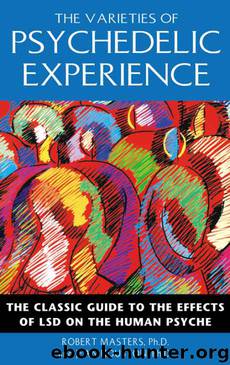The Varieties of Psychedelic Experience: The Classic Guide to the Effects of LSD on the Human Psyche by Robert Masters Ph.D. & Ph.D. Houston Jean

Author:Robert Masters Ph.D. & Ph.D. Houston Jean [Masters Ph.D., Robert]
Language: eng
Format: mobi
Publisher: Inner Traditions Bear & Company
Published: 2000-03-31T16:00:00+00:00
Tactile Experiences. Some of the most important and interesting experiences on the sensory level are those involving tactile phenomena and unusual kinds of body feeling. The more pleasurable of these experiences are most likely to occur in a nature setting since subjects almost always prefer the natural out-of-doors environment and have a high degree of sensory and other openness to it. This extraordinary openness especially facilitates certain types of empathic experience rarely encountered under other conditions.
Empathy in the natural setting may differ in several significant respects from that usually experienced indoors. First of all, the subject, almost from the start, already has achieved a kind of empathy with his surroundings as a whole, although not with any particular object. That is to say, nature seems to the subject a whole of which he is an integral part, and from this characteristic feeling of being a part of the organic “body of nature” the subject readily goes on to identify with nature in its physical particulars and processes. No drug subject similarly identifies with a room or other artificial environment, and the empathy with nature seems to be especially abetted by the warming rays of the sun, the playing of the breezes over the subject’s body, his contact with the earth below him, and various other types of tactile experiencing of the environment.
This larger empathy or harmony with nature then may become particularized through the physical contact. The subject, at first subconsciously, becomes related in a tactile-empathic way to that stimulus with which he is effectively in contact. Then he gradually becomes aware of some part of his body as partaking of the substance of the earth or stone or grass upon which he stands, or of the air around him, the sunlight, or the wind. The sense of physical separateness increasingly diminishes and may be altogether lost—sometimes moving the subject towards a mystical-type experience. But what is unusual here is that the body-nature empathy or synonymity begins with a preconscious physical merging with the environment so that by the time the subject becomes aware of his “tactile-empathy,” of his identity with grass or stone, the empathic state already is fait accompli. Then may follow the “psychological empathy”—the psychical at-oneness with the object which is the more commonly occurring type of indoors empathy with objects. In another sort of tactile (partial) identification with the environment, the subject retains his awareness of his body’s outlines and separateness from the environment, but feels that his substance now is the same as that of some part of the environment. Thus, he reports that his body or some part of it feels as if it has become the stone or clay upon which he stands, or that his hands have become like the water into which they were dipped—these “watery hands,” however, retaining their form and a kind of comparative solidity. Two subjects, thrusting their hands into dusty earth, have experienced an instantaneous metamorphosis of substance—”So, it is true! Dust into dust!”
A number of subjects,
Download
This site does not store any files on its server. We only index and link to content provided by other sites. Please contact the content providers to delete copyright contents if any and email us, we'll remove relevant links or contents immediately.
| Dictionaries & Terminology | Drug Guides |
| Education & Training | Instruments & Supplies |
| Medical Atlases |
When Breath Becomes Air by Paul Kalanithi(7263)
Why We Sleep: Unlocking the Power of Sleep and Dreams by Matthew Walker(5641)
Paper Towns by Green John(4169)
The Immortal Life of Henrietta Lacks by Rebecca Skloot(3826)
The Sports Rules Book by Human Kinetics(3588)
Dynamic Alignment Through Imagery by Eric Franklin(3488)
ACSM's Complete Guide to Fitness & Health by ACSM(3468)
Kaplan MCAT Organic Chemistry Review: Created for MCAT 2015 (Kaplan Test Prep) by Kaplan(3423)
Introduction to Kinesiology by Shirl J. Hoffman(3299)
Livewired by David Eagleman(3121)
The River of Consciousness by Oliver Sacks(2992)
Alchemy and Alchemists by C. J. S. Thompson(2911)
The Death of the Heart by Elizabeth Bowen(2901)
Descartes' Error by Antonio Damasio(2731)
Bad Pharma by Ben Goldacre(2729)
Kaplan MCAT Behavioral Sciences Review: Created for MCAT 2015 (Kaplan Test Prep) by Kaplan(2491)
The Gene: An Intimate History by Siddhartha Mukherjee(2491)
The Fate of Rome: Climate, Disease, and the End of an Empire (The Princeton History of the Ancient World) by Kyle Harper(2436)
The Emperor of All Maladies: A Biography of Cancer by Siddhartha Mukherjee(2431)
